12+ Referral Incentives Ideas With Real-world Examples
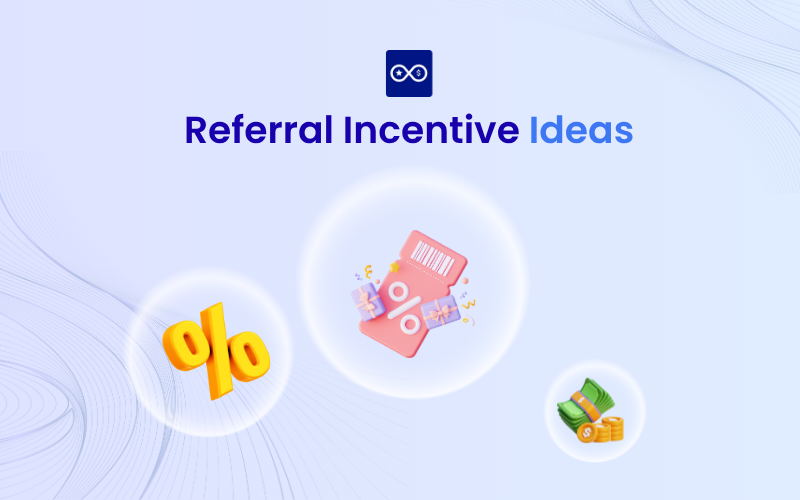
Word-of-mouth marketing isn’t new, but it’s never been more valuable. According to Nielsen, 92% of consumers trust recommendations from people they know, and that trust translates directly into revenue. Yet many businesses leave this opportunity on the table by failing to systematically reward advocates. That’s where referral incentives come in.
Referral incentives are structured rewards designed to turn satisfied customers into active promoters. Whether it’s a $20 discount, free product upgrade, or exclusive access, these incentives create a powerful feedback loop: happy customers refer friends, new customers arrive pre-validated, and your acquisition costs plummet.
In this guide, we’ll explore 12+ proven referral incentives ideas used by leading brands like Dropbox, Morning Brew, and SimpliSafe. You’ll learn how to structure incentives for maximum ROI, implement them without friction, and adapt them to your specific business model, whether you’re running a Shopify store, SaaS platform, or service-based business.
Let’s dive in.
What Are Referral Incentives? (Definition & Impact)
Referral incentives are rewards or benefits, including cash, discounts, free products, or exclusive perks, offered to customers who successfully refer new buyers or leads. The mechanic is simple: refer a friend, earn a reward. But the impact is profound.
Key Benefits of Referral Incentives:
- Increased customer acquisition: Referred customers often have higher conversion rates than cold traffic.
- Lower marketing costs: Referral programs typically deliver CAC (Customer Acquisition Cost) 25–50% lower than paid advertising.
- Stronger loyalty and retention: Advocates become more engaged and loyal to your brand.
- Higher-quality customers: Referred customers tend to have better LTV (Lifetime Value) and lower churn.
>> You may also like:
- 60+ Referral Program Examples You Can Copy 2026 (By Industry)
- 20+ Referral Program Ideas For eCommerce That Definitely Works in 2026
12+ Powerful Referral Incentive Ideas (+ Real-World Examples)
To help you navigate options, here’s a quick comparison of incentive structures:
| Incentive Type | How It Works | Ideal Use Cases | Typical Participation Rate |
| Double-Sided Rewards | Both referrer and referred customer receive a benefit | Consumer products, general eCommerce | 25–35% |
| Tiered Rewards | Rewards increase based on referral volume or milestones | Growth-focused programs, gamified campaigns | 20–30% |
| Store Credit / Service Credits | Referrers receive account credit, discounts, or usage credits | SaaS, subscription-based or repeat-purchase brands | 18–25% |
| Cash & Gift Cards | Monetary or gift card payout for each successful referral | Broad appeal, works across most industries | 22–28% |
| Charitable Contributions | A donation is made on behalf of the referrer (or both parties) | Mission-driven or sustainability-focused brands | 15–22% |
| Exclusive Access / VIP Perks | Early product access, waitlist priority, or community benefits | Premium, lifestyle, or brand-loyalty-driven markets | 18–24% |
Now, let’s explore each idea in detail.
1. Double-Sided Rewards (Both Parties Win)
- Why it works: Double-sided incentives feel fair and generous. Both the referrer and their friend benefit, removing hesitation and creating a “win-win” social narrative that’s highly shareable.
- Real Example: Omsom’s “Give $5, Get $5” program offers $5 credit to both parties. The result? They scaled referral sign-ups by 40% within the first quarter of launch.
- Implementation tip: Use tiered double-sided rewards (e.g., $10 + $10 for first referral, $15 + $15 for the second) to encourage repeat advocacy.
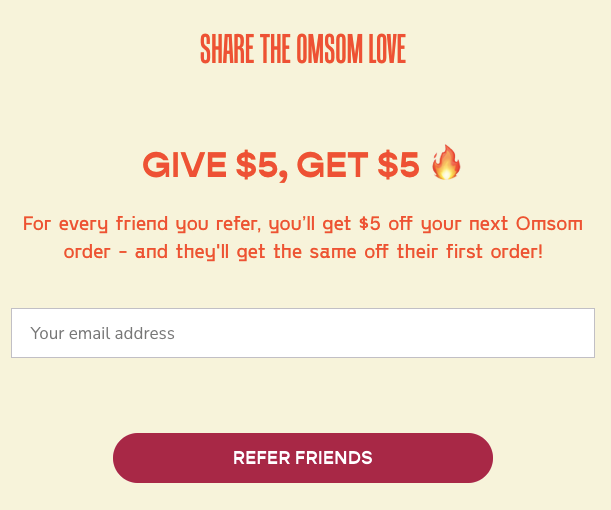
2. Tiered & Milestone Rewards
- Why it works: Gamification taps into competitive instincts and status-seeking behavior. Escalating rewards create clear achievement markers and motivate power users.
- Real Example: Morning Brew offers escalating rewards: 1 referral = standard gift, 5 referrals = exclusive branded stickers, 1000 referrals = trip to Brew HQ. Their leaderboard-style presentation drives a 50–60% increase in monthly referral volume.
- Implementation tip: Set milestone thresholds relative to your audience. For a SaaS product with 10,000 users, a 5-referral milestone is more achievable than a 50-referral one.

3. Service Discounts & Store Credits
- Why it works: Credits keep value in-house, encourage repeat purchases, and are easy to fulfill at near-zero marginal cost. Particularly effective for recurring revenue models.
- Real Example: Stitch Fix awards $25 credit per successful referral, redeemable on any purchase. The strategy keeps referred customers engaged within the platform and increases customer lifetime value.
- Pro tip: Combine with a usage deadline (e.g., “credit expires in 90 days”) to drive urgency and repeat engagement.

4. Cash & Gift Cards
- Why it works: Cash is universally motivating and requires no guesswork. Pre-loaded gift cards (Visa, Amazon) appeal to broader audiences and feel more substantial than abstract credits.
- Real Example: SimpliSafe offers a $200 Visa prepaid gift card for each successful security system referral. High-ticket products justify premium rewards; this strategy has contributed to their 35% YoY referral growth.
- Implementation tip: For lower-AOV businesses, offer smaller increments ($5–$15). For higher-AOV, go bigger ($50–$200).
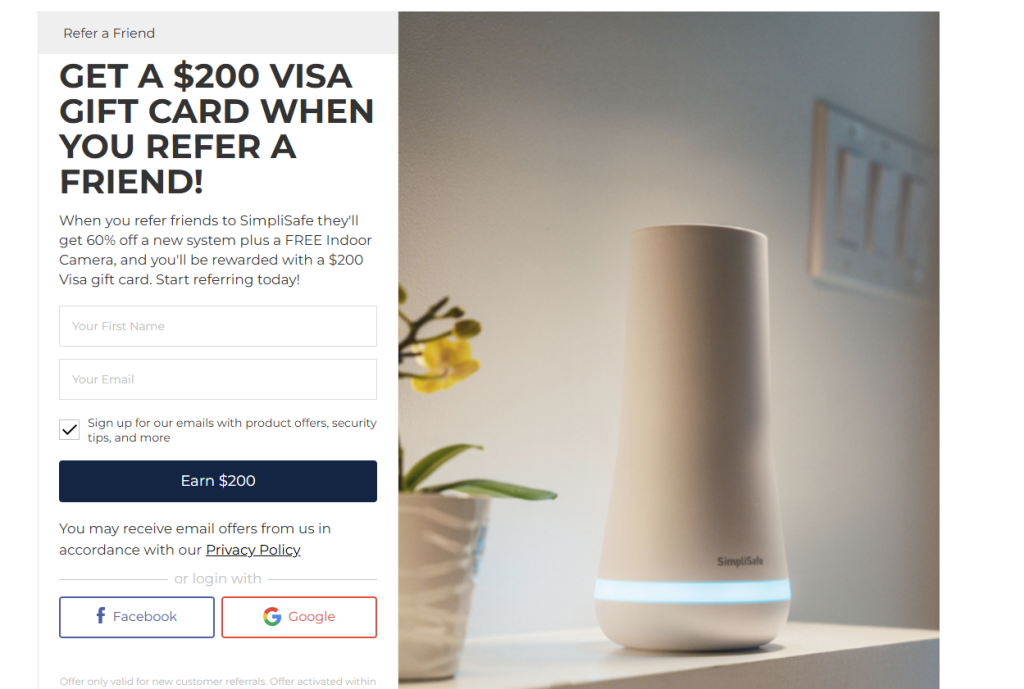
5. Free Add-ons, Upgrades, or Products
- Why it works: Product rewards are low-cost, excite customers, and create unboxing moments perfect for social sharing.
- Real Example: Dropbox pioneered the free storage incentive: +500 MB per successful referral. This single mechanic drove their user base from 100,000 to 4 million users. The beauty? Storage costs them pennies per GB but feels valuable to users.
- Best for: SaaS, software, subscription boxes, and physical product businesses.
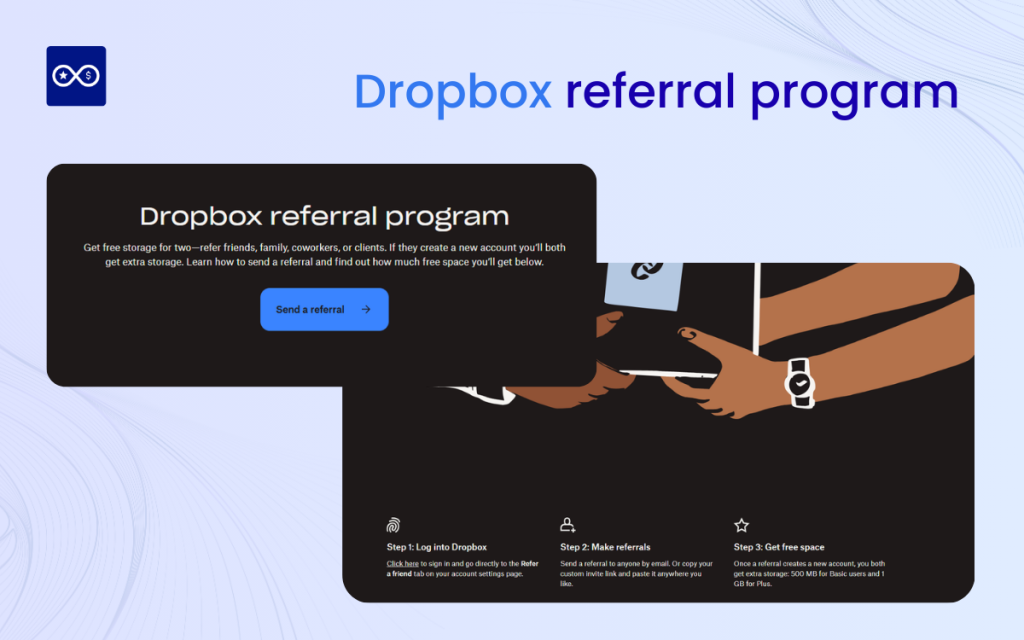
6. Exclusive Access & VIP Perks
- Why it works: Scarcity and status trigger powerful psychological motivators. Early product access, limited-edition items, or VIP event invitations appeal to brand enthusiasts and trend-setters.
- Real Example: Harry’s (men’s grooming brand) rewards top referrers with early access to new razor designs and exclusive grooming product bundles. This strategy strengthens brand community and generates user-generated content on Instagram.
- Implementation tip: Segment advocates by referral volume and offer tiered VIP status (Bronze, Silver, Gold) with escalating perks.
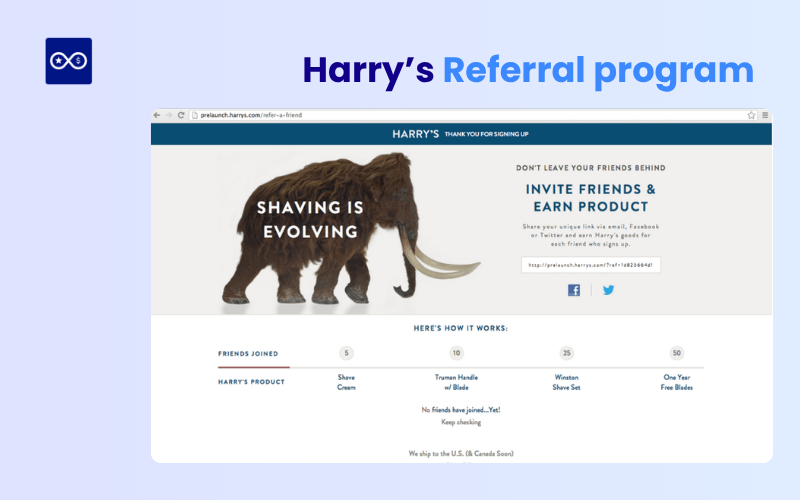
7. Referral Contests & Seasonal “Burst” Campaigns
- Why it works: Time-limited contests create urgency and competitive energy. Limited-time doubled rewards or prizes spike referral activity.
- Real Example: Extole (referral marketing platform) reports that seasonal “burst campaigns”—running double or triple rewards for 2–4 weeks—generate up to a 200% spike in referral volume, with sustained elevation even after the campaign ends.
- Best practice: Run bursts during peak shopping periods (Black Friday, holiday season, back-to-school) or product launch windows.
8. Loyalty Points / Multi-Referral Bonuses
- Why it works: Points systems integrate seamlessly with existing loyalty programs, gamify progression, and reward repeat behavior. They feel less transactional than one-off rewards.
- Real Example: Morning Brew uses a progress bar system where each referral earns points toward milestone rewards. Subscribers can track their progress in real time, encouraging continued advocacy.
- Implementation tip: Allow points redemption across multiple categories (discounts, free products, exclusive content) to appeal to different motivations.

9. Charitable Donations in Referrer’s Name
- Why it works: For socially motivated customers, impact-driven rewards outperform cash. Donating to a cause in the referrer’s name ties brand values to action and generates positive PR.
- Real Example: Toggl Plan (project management tool) plants a tree for each new customer referred. This resonates with their environmentally conscious audience and generates social proof (“I helped plant 50 trees this year!”).
- Best for: Purpose-driven brands, nonprofits, and B2B SaaS companies targeting millennial/Gen Z buyers.
10. Partnerships & Cross-Promotions
- Why it works: Co-marketing with complementary brands expands reach, increases perceived reward value, and shares acquisition costs.
- Real Example: A local garden center + landscaping company might offer: “Refer a landscaping client and get 20% off plants” (garden center) + “Refer a landscaping client and get 15% off mulch” (landscaper). Both businesses reach each other’s audiences without additional marketing spend.
- Pro tip: Partner with non-competing brands that serve your audience (e.g., fitness brand + healthy snack company).
11. Surprising “Mystery” Rewards or Birthday Bonuses
- Why it works: Unexpected rewards trigger delight and social sharing. Birthday bonuses add a personal touch and increase engagement around customer anniversaries.
- Real Example: A subscription box service might send a handwritten note + mystery bonus item to referrers who successfully convert 3+ friends within a calendar quarter. The personalization sparks organic Instagram posts and word-of-mouth.
- Implementation tip: Use customer data to time birthday bonuses and add a 2x referral multiplier during their birth month.
12. Social Media Shoutouts & Public Recognition
- Why it works: For status-motivated customers, public recognition outperforms monetary rewards. Shoutouts create aspirational content and encourage peer competition.
- Real Example: Brands with strong communities feature top referrers in Instagram Stories, monthly newsletters, or a “Hall of Fame” page. This drives non-monetary motivators (status, belonging) and generates user-generated content.
- Implementation tip: Create branded hashtags (e.g., #MorningBrewReferral) and repost customer advocacy across your social channels.
13. Experiential Rewards (Bonus Idea)
- Why it works: Experiences create lasting memories and social sharing. Concert tickets, classes, or trip vouchers often generate more enthusiasm than cash.
- Real Example: A premium e-commerce brand might offer concert tickets or weekend getaway packages for referrers who hit 10-referral milestones. The high perceived value justifies the lower participation rate.
Case Studies—How Leading Brands Structure Incentives
PayPal’s $10 + $10 Model
- Incentive: $10 credit for referrer + $10 for referred friend.
- Why it works: Simple, double-sided, and universally valuable. The $20 combined incentive felt generous in early 2000s and drove massive viral adoption.
- Results: Referral program contributed to 7% of new account signups at peak.
- Shopify adaptation: A merchant could offer $10 store credit per referral—low cost but high motivation for their customer base.
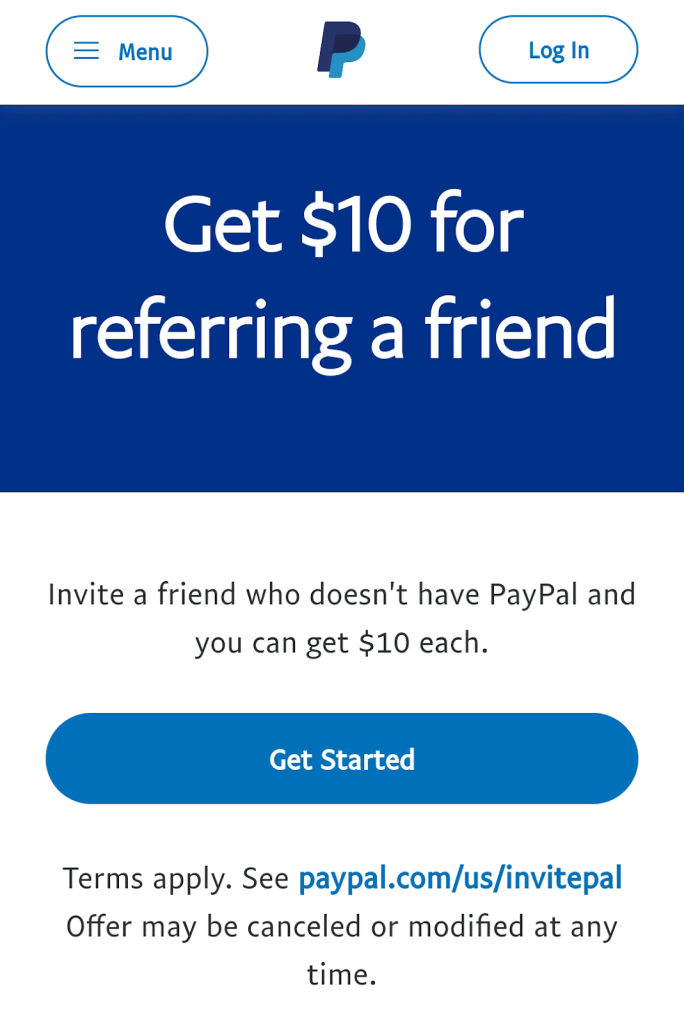
Casper’s Tiered Mattress Rewards
- Incentive: $50 credit for 1 referral, $150 for 3, and up to $500 for 10+.
- Why it works: Mattress shopping is high-consideration; strong incentives overcome hesitation. Tiering encourages repeat sharing.
- Results: Referral-sourced customers have 15% higher retention than average.
- Shopify adaptation: Premium product sellers can model this by setting milestones relative to product AOV.

Stitch Fix’s Credit-Based Model
- Incentive: $25 credit per referral, redeemable on future purchases.
- Why it works: Keeps customers engaged in the platform, drives repeat spending, and builds loyalty loops.
- Results: Referral customers spend 40% more in years 2–3 than non-referred customers.
- Adaptation: Service-based businesses can use service credits instead of cash.

How to Choose the Right Incentive(s) For Your Brand
Selecting the right incentive requires clarity on your business model and audience.
Key Factors to Evaluate
- Average Order Value (AOV): Lower AOV ($10–$50) suits smaller incentives ($5–$15). Higher AOV ($200+) justifies premium rewards ($50–$200).
- Profit Margin: Only spend 10–20% of gross profit per referral. If your margin is 40% and AOV is $100 (gross profit: $40), cap incentives at $4–$8.
- Customer Lifetime Value (LTV): If LTV is $1,000, a $50 incentive ROI is breakeven on referral acquisition alone.
- Industry & Audience: B2B SaaS audiences respond to exclusive access. E-commerce audiences prefer cash/credits. Nonprofits’ supporters prefer impact-driven rewards.
- Seasonality: Seasonal businesses should run burst campaigns during peak seasons (2–3x normal rewards).
Testing & Optimization
Run A/B tests on incentive type and size:
- Test 1: Single-sided ($10) vs. double-sided ($5 + $5)
- Test 2: Cash vs. product credit vs. exclusive access
- Test 3: Fixed vs. tiered thresholds
Measure participation rate, conversion rate of referred customers, and ROI. Run each test for 2–4 weeks minimum to gather statistical significance.
Advanced Tactics—Promotion, Personalization, and Fraud Prevention
Structuring the incentive is half the battle; promotion and execution are equally critical.
Promotion Channels
- Email: Post-purchase automation (“Your order shipped—refer a friend and earn $10 credit”).
- On-site prompts: Exit-intent popups, sidebar widgets, post-purchase thank-you pages.
- Product packaging: Include a referral card or QR code with shipments.
- Social media: Instagram Stories, TikTok, or Pinterest boards encouraging user-generated referral content.
- Dedicated landing page: SEO-optimized referral hub with clear CTAs and social proof.
Personalization Strategies
- Segment by customer tier: VIP customers unlock higher rewards or faster payouts.
- Behavior-based timing: Send referral prompts 2 weeks after first purchase (when satisfaction peaks).
- Exclusive offers: Long-term customers unlock bonus referral multipliers (2x or 3x rewards).
- Geographic targeting: Customize rewards by region (e.g., local gift cards vs. national).
Fraud Prevention
- Unique tracking links: Each customer receives a unique URL; bulk link sharing triggers fraud flags.
- Self-referral blocks: Prevent customers from referring their own accounts.
- Velocity checks: Flag accounts making 50+ referrals/day (likely bot activity).
- Email/phone validation: Confirm referred customers provide valid contact info.
- Manual review: Audit high-value referrals for legitimacy before payout.
FAQs on Referral Incentives & Best Practices
How big should my incentive be?
Start with 10–20% of your AOV or gross profit per referral, whichever is lower. A/B test increments and optimize based on participation rate and ROI.
Can you automate referral tracking and payouts?
Absolutely. Platforms like Referralcandy, KickoffLabs, and Refersion automate link tracking, conversion attribution, and payout via PayPal, Stripe, or store credit. Recommended for any program expecting 100+ referrals/month.
What metrics should I measure?
- Referral participation rate (% of customers who refer)
- Conversion rate (% of referred leads that convert)
- Cost per acquisition (incentive spend ÷ new customers)
- Referred customer LTV and retention
- ROI (revenue from referrals – incentive costs)
Best ways to prevent referral fraud?
Use unique links + email validation, cap rewards per customer, monitor velocity spikes, and manually audit high-value referrals. Fraud is rare if incentives are < $50.
Can I run multiple incentive types at once?
Yes. Segment customers and test different incentives: VIP tier gets exclusive access, standard tier gets cash, loyalty members get points. Personalization increases conversion rates.
In conclusion,
Referral incentives ideas work because they align customer motivation with business growth. A well-designed program—combining the right incentive type, clear communication, and automated execution—can reduce CAC by 30–50% while increasing customer quality and retention.
The brands winning with referrals (Dropbox, PayPal, Morning Brew) don’t rely on chance. They test incentive structures, measure rigorously, and refine constantly. You can do the same.
Start small: pick one incentive (double-sided rewards are easiest), launch to 20% of your customer base, measure results, and scale. Within 90 days, you’ll have data on what works for your audience.
The question isn’t whether referral incentives work—it’s how fast you can implement them.
Ready to Launch Your Referral Program?
Building a referral program from scratch is complex, but it doesn’t have to be. Explore Bloop’s referral management tools to automate tracking, payouts, and customer communications in minutes—no coding required. Trusted by 2000+ e-commerce brands and SaaS companies to scale customer acquisition efficiently.
>> Start your free 14-day trial today and see how much growth you can unlock.